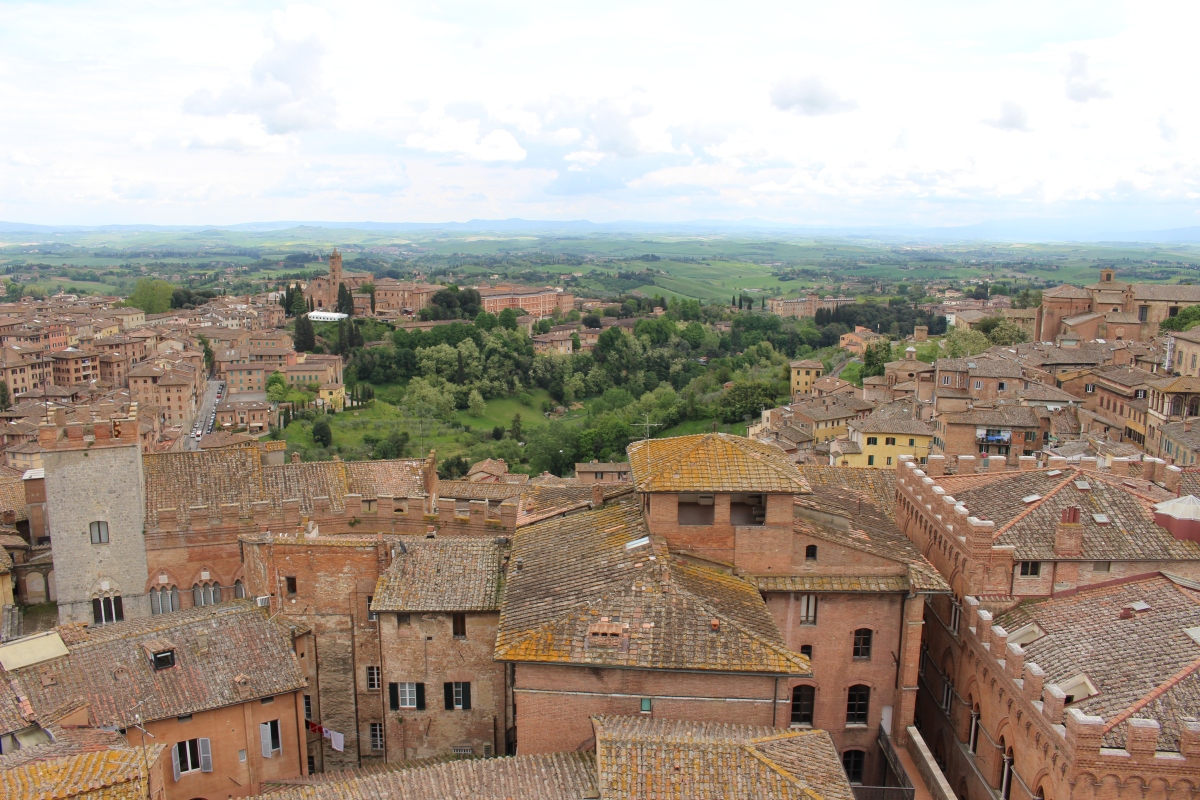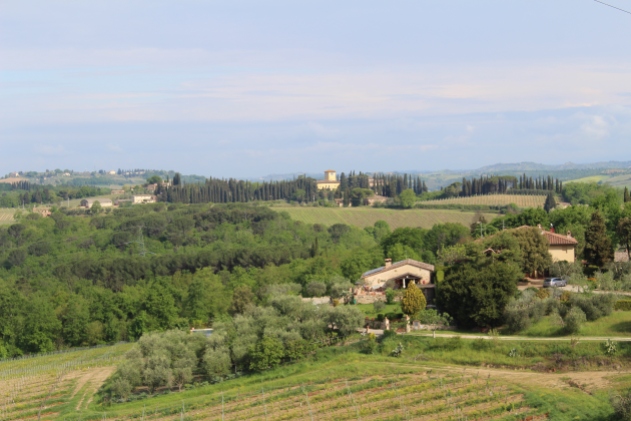After Chef Mike cooked up his eggs Florentine (eggs with cheese and spinach) and plain toast, accompanied by peach juice and espresso, we were on our way to Siena. The forecast was for rain, so we took our raincoats and umbrellas despite the day’s auspicious partly-sunny beginnings. Actually, clouds scuttled across the sky, but I held on to my optimism through much of the day, until it actually started raining in Siena at 2:30.
We stopped along the way to take pictures of the beautiful farms lined with cypress trees.

cypress trees all lined up
On the way into Siena, one of Italy’s best preserved medieval towns, we passed the huge Basilica of San Dominico, an imposing red brick box begun in 1226. Named for the founder of the Dominican order, it is now more closely associated with St. Catherine of Siena (1347-1380).

entering Siena

Basilica of San Dominico
We stopped first for coffee and croissants and then bought tickets for one of Italy’s finest Gothic churches, Siena’s Duomo, or Cathedral. It was completed in two brief phases at the end of the 13th and 14th centuries. Giovanni Pisano designed the white, green and red marble facade. Multicolored marbles and painted decoration seemed to be the Italian approach to Gothic architecture.

Duomo di Siena

The Duomo has a striking interior with black and white striped columns and a gilded dome. It holds the oldest example of stained glass in Italy (1288) in a circular window; the carousel pulpit, carved by Nicola Pisano in 1265, and Renaissance frescoes in the Biblioteca Piccolomini.

Duomo di Siena

Duomo di Siena

Duomo di Siena

Life of Virgin Mary Stained Glass, 1288, in Duomo di Siena
The Duomo is famous for its inlaid marble floors, which took nearly 200 years to complete. They include 56 separate compositions, including Biblical scenes, allegories, religious symbols, and civic emblems. These sorts of “Bible in images” were created between 1369 and 1547 to the designs of great painters such as Matteo di Giovanni and Dominico Beccafumi.

the Duomo’s inlaid marble floors

the Duomo’s inlaid marble floors

the Duomo’s inlaid marble floors
The interior was exquisite in many ways.
We then went into the Museo dell’Opera, where we waited in line for a while to climb the tower inside the museum, the Panorama del Facciatone. They only allowed 28 people go up at a time as the stairway up was extremely narrow. People who climbed up were only allowed 15 minutes at the top.

View of Siena from the Panorama del Facciatone

View of Siena from the Panorama del Facciatone

View of Siena from the Panorama del Facciatone

View of Siena from the Panorama del Facciatone

View of Siena from the Museum
We walked briefly through the Museo dell’Opera, which contains the Duomo’s treasury and some of the original decoration from its facade and interior.
The masterpiece at the museum was Duccio di Boninsegna’s Maestà (1308-1311). One side of the altarpiece had 26 panels showing episodes of the Passion, and the other side had a Madonna and Child Enthroned. Duccio’s Maestà set Italian painting on a course leading away from the representations of Byzantine art towards more direct presentations of reality.

The Maestà, or Maestà of Duccio
Also in the Museo dell’Opera:
We popped into the Battistero di San Giovanni, the Duomo’s 14th century Gothic Baptistery, built to prop up the apse of the cathedral. There were beautiful frescoes throughout. The highlight was the huge bronze 15th century baptismal font designed by Jacopo della Quercia (1374-1438).

Battistero di San Giovanni
After the Battistero, we went in search of lunch. We settled into a small outdoor cafe on a side street, Ristorante Le Campane, where I finally discovered one of the orange drinks I’d seen everywhere, Aperol Spritz, vino bianco secco e soda (dry white wine and soda).

streets of Siena

I was finally able to order the dish my daughter Sarah had recommended: Picio Cacio e pepe: Homemade Sienese pasta with black pepper and pecarino (ewe’s milk) cheese. Mike ordered a Pumpkin Velouté with sausage crumbles (a soup) and a side dish of spinach and Swiss chard.
It was all yummy, and we relaxed at the cute outdoor cafe with greenery and flowers hugging the balcony. We thanked the waiter: “Va tutto benissimo, grazie,” or “Everything’s great, thank you.”
We strolled down to the Piazza del Campo, a fan-shaped sloping plaza simply known as il Campo (The Field). It was built toward the end of the 12th century and is the heart of the town. The focal point of the Piazza is Palazzo Pubblico, a Gothic building that has served as Siena’s town hall since the 1300s. Its distinctive bell tower, Torre del Mangia, completed in 1349, apparently offers superb views, but we didn’t climb.
On July 2 and August 16 of each year, the Palio, the famous horse race preceded by a splendid historical procession, takes place at il Campo.

il Campo and Palazzo Pubblico

il Campo

il Campo

il Campo
It started raining at 2:30, so we headed toward our parked car. Our parking expired at 3:30, so on the way out of town, we dipped into a scarf shop. I would have bought two more Italian scarves, but the saleswoman reprimanded me for taking one of the €59 scarves off the rack and trying it on; she pointed to a sign written in Italian. I said, “I’m sorry, I don’t read Italian,” and she said she’d have to write it in every language to accommodate every tourist. As we were the only ones in the shop, she easily could have told us directly not to try on her scarves. It was ridiculous and I refused to patronize someone so unaccommodating and rude. There was no skin off my neck; I’d bought plenty of scarves already. 🙂

last view of Siena
Leaving Siena, we drove on to Monteriggioni.
*13,001 steps, or 5.51 miles*
Saturday, May 4, 2019*














































Gorgeous pictures of Sienna , especially the interior of the Cathedral. Mine were mostly dark so your detailed ones refreshed my memories beautifully. Another fab post Cathy!
LikeLike
Thanks so much, Sheetal. I’m glad you liked Siena. It was rather overcast that day, and even rained some, so I think mine are rather dark too. I’m glad to have refreshed your memory. 🙂
LikeLiked by 1 person
Don’t take scarves from the rack. Prepare for the sellers to be rude. Sound like rules for those who don’t want to keep a store. I’m glad that most of your visit to Siena was impressive (positively) and pleasant. Traveling through Tuscany (I like the photograph of the small car), visiting museums (trying to avoid crowds, and I’d avoid high places), and patronizing cafes (the drink you have looks good). Quite the traveling style. And inspirational. Molto bene, Cathy! (I’m not entirely sure what I just said, beyond your name.)
LikeLike
I don’t know why people are the way they are, Christopher. I’m sure I could be more patient and forgiving myself, but sometimes I’m so annoyed by people, and I’m not one to remain silent. I’ve gotten in plenty of trouble for my outspokenness over the years.
I do love the Fiats! I’ll show more of those in a later post. The food and drink in Italy is always marvelous. You can’t imagine it. I always wondered how people could rave about Italian food when I’d always been underwhelmed by most of it in Italian-American restaurants. It’s exquisite freshly made there. My mouth waters just thinking about it. Especially now that I’m on a very restricted diet trying to get my silent reflux under control. Molto bene to you too! 🙂
LikeLike
Siena is one of my favourite places in Italy. I just love sitting in that enormous square having a coffee or a glass of wine and people watching. We were there the week before the Palio when the local confraternities paraded in their costumes. Quite impressive. It’s a beautiful place but by the time we’d arrived there I had had enough of churches so deliberately avoided the one in Siena. I’m glad i have your pictures to see what it was like.
LikeLike
I think I would love nothing better than to while away an afternoon in an Italian town, drinking wine or coffee and watching the world go by. It bet it was exciting to be there before Palio, with all the parades and costumes. I loved the inside of Sienna’s Duomo, with those floors and the amazing striped columns. It is a beautiful place all around. 🙂
LikeLike
It snowed the day we were there, very cold. We climbed something in a gale, I think probably the bell tower, and had a thoroughly good time. As this was Christmas1992 we have very few photos so it is lovely to see yours.
LikeLike
I’m glad to have brought back happy memories, Anabel, despite it being freezing cold when you were there. As you could see it was overcast and even rainy when we were there. It is a lovely town. 🙂
LikeLiked by 1 person
I’m enjoying this Italian jaunt with you. The scenery is so beautiful.
LikeLike
Thank you, Carol. Have you been to Italy? If so, which part? There is still so much to explore there. 🙂
LikeLike
We haven’t yet been to Italy. Hopefully one day…
LikeLike
I hope so! So many places to go in the world, and at this moment we can’t go to any of them. 😦
LikeLiked by 1 person
We’re fortunate that, at this stage, we are allowed to travel to most states in Australia. Not that we’re planning any big trips just yet, still waiting to see what happens long term. But we have done a couple of day trips and a long weekend.
LikeLike
We can travel to most places in the U.S., but do we want to? Especially the south, where infections are rising in huge numbers every day. Have fun planning. 🙂
LikeLiked by 1 person
Another exotic Italian adventure with you….I am learning about places I dont think I would be visiting soon
LikeLike
Thanks so much, Indra. Yes, I don’t think any of us will be traveling soon. 😦
LikeLiked by 1 person
The Basilica is very dominant and ugly, but the Duomo is beautiful, though I think I’d be getting all churched out by now! Sitting in the square and eating Italian food with a glass of wine would be wonderful though. I would be very happy to be doing that. Though possibly not at the moment!
LikeLike
That Basilica certainly does dominate! The Duomo is beautiful and I was very impressed with the interior as well. Yes, we loved sitting and eating and drinking wine probably more than anything in Italy. 🙂
LikeLike
Your shots of Siena are stunning, Cathy. This is Siena by daylight for me, through your post. We swung into it in the evening and as entrancing as it looks at night, we both feel now that it calls for a re-visit. The pici looks so good! Om nom nom. xx
LikeLike
Thanks so much; I’m glad you liked seeing Siena in daylight. That Picio Cacio e pepe was simple, but exquisite! 🙂
LikeLiked by 1 person
And this is how we shall press on, with memories of our precious travels! And pangs for them (I get the pangs intensely time and again). x
LikeLike
I get those pangs too! All the time! 🙂
LikeLiked by 1 person